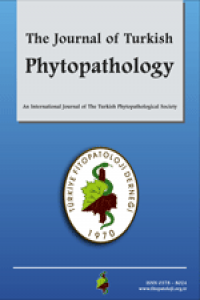Biberden İzole Edilen Xanthomonas Axonopodıs pv. Vesicatoria İzolatlarının Tüm Hücre Yağ Asit Kompozısyonu
Öz
-
Anahtar Kelimeler
Whole Cell Fatty Acid Composition of Xanthomonas axonopodis pv. vesicatoria Strains, Isolated From Pepper
Öz
Bacterial spot, caused by Xanthomonas axonopodis pv. vesicatoria, is one of the most important disease of pepper (Capsicum spp.) in the eastern Mediterranean region of Turkey. During 2002-2004, plant samples with bacterial spot symptoms were collected from 83 commercial fields in Adana, Osmaniye, and Mersin provinces. X. axonopodis pv. vesicatoria were isolated and identified by traditional methods. Whole cell fatty acid methyl ester (FAME) analysis in Sherlock Microbial Identification System (MIS) with database of prokaryotes was used together with traditional methods for identifying and phenotypically characterization of the strains. One hundred and seventy bacterial strains were identified as X. axonopodis pv. vesicatoria by traditional methods and pathogenicity tests. Identification of the selected 19 strains was confirmed by FAME analysis with similarity indices ranging from 37-76%. Total 24 different fatty acids were detected in the whole cell of X. axonopodis pv. vesicatoria strains selected. Fifteen fatty acids were found in all strains as major fatty acids. X. axonopodis pv. vesicatoria strains tested were divided into two different groups in terms of FAs concentration and composition. There was no correlation between geographical origin and FA groups of the strains. The results suggested that MIDI system was useful for confirming the identity of bacterial spot pathogen at the species level, but not pathovar and strain level. Therefore, FAME analysis combined with traditional methods and pathogenicity test was good enough for identification and characterization of the pathogen at the pathovar and strain level
Anahtar Kelimeler
Bacterial spot pepper microbial identification fatty acid methyl ester analysis
Ayrıntılar
| Birincil Dil | Türkçe |
|---|---|
| Bölüm | Makaleler |
| Yazarlar | |
| Yayımlanma Tarihi | 1 Eylül 2005 |
| Yayımlandığı Sayı | Yıl 2005 Cilt: 34 Sayı: 1-2-3 |


